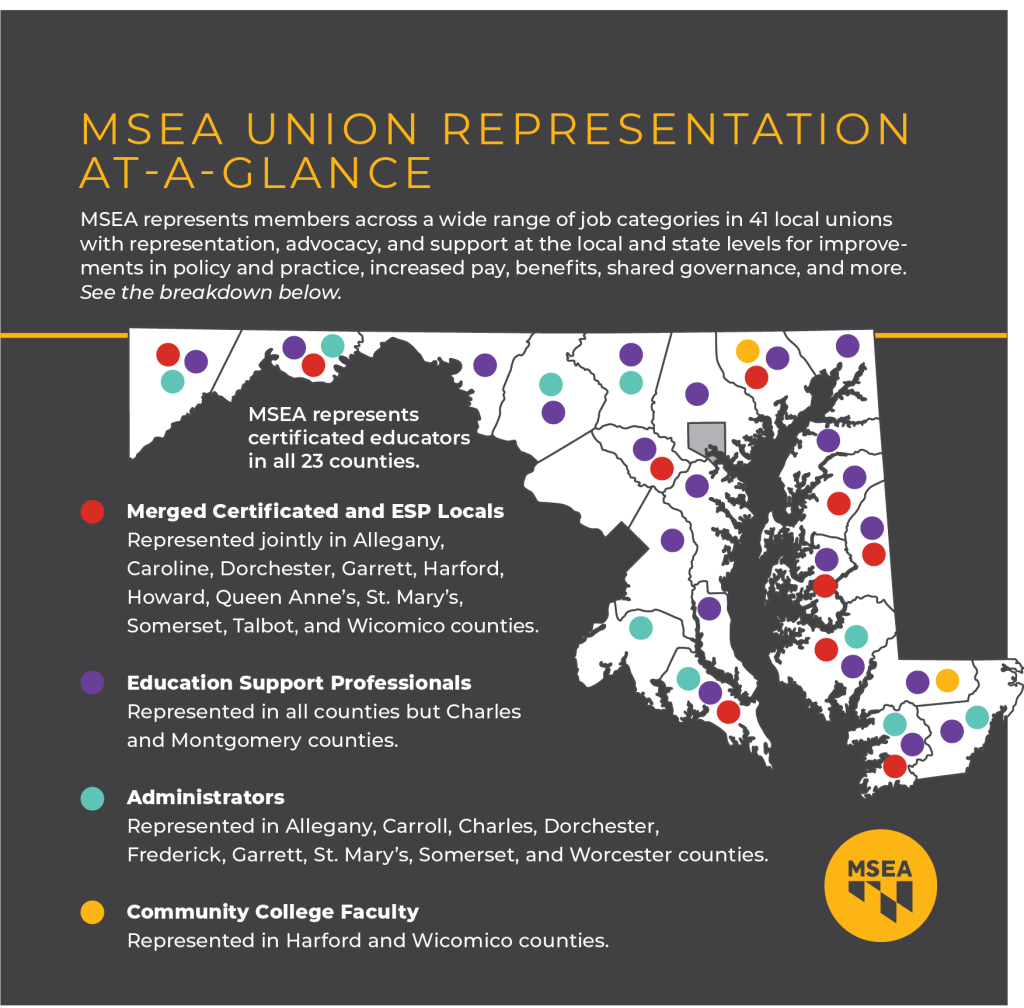One Union! One Voice!
MSEA Welcomes Community College Faculty

Every union has units of employees it represents. MSEA, which has long represented certificated educators, support professionals, and administrators (in six counties), is now welcoming fulltime community college faculty to our larger union family.
In 2021, legislation passed by the Maryland General Assembly gave community college employees the right to unionize and win improvements in pay, benefits, and working conditions through collective bargaining. It’s the latest new group of public education employees to join MSEA’s 75,000 members since the first administrator unit organized and was represented by the Education Association of Charles County in 1969.
Since then, local teacher and support staff unions in severalcounties have merged, following the example set by Howard County in 1989 and forming more powerful voices for public education in their locals. “With the addition of administrators, and now community college faculty, our union is growing in numbers and strength,” said MSEA President Cheryl Bost.

“These added voices raise the volume on issues that affect public education from pre-k to college level. Making those connections means stronger and better learning outcomes for students throughout their education and that, in turn, means a bigger boost to their community and workforce. We’re excited to welcome the full-time faculties from Wor-Wic Community College in Salisbury and Harford Community College in Bel Air.”
Why Unionize?
In 2021, and every year before, full-time higher education faculty in unions were paid more than non-union faculty in the same states. In fact, faculty in unions earn about $5,000 more than non-unionized faculty in the same states, and they earn $17,000 more than in states where faculty do not have the right to unionize. The biggest difference, however, is at community colleges and other two-year institutions, where union faculty earn an additional $18,000, or 27% more, than their peers in the same states.
Wor-Wic Community College (WWCC) has an enrollment of 7,000 students with 68 full-time faculty. Harford Community College (HCC) has an enrollment of 6,000 students with 104 full-time faculty. Wherever the campus, community college educators like those at WWCC and HCC have long been underpaid.
The fight to unionize has been fraught for WWCC faculty. With a college president who testified to the General Assembly in 2021 against the right to organize, and who insisted unionization would hurt students, many professors felt threatened about even discussing unionizing openly.

With some obstructions out of the way, faculty organizers at WWCC—and no doubt across the state—feel vindicated and empowered to begin their campaigns for improving faculty jobs with a new union voice and a negotiated contract. The top items on both WWCC’s and HCC’s list of reasons to unionize are long-simmering issues of salaries and benefits, job protections, academic freedom, and the wish for shared governance.
“I want WWCC to be the best community college it can be and that can only be done with a union helping to protect our rights and provide the unified voice we need to create an environment that professors will thrive in,” said Kevin Justice, an assistant professor of computer studies and faculty organizer at WWCC.

“We’re learning that a union is us and that’s a paradigm shift for academics who are somewhat isolated in our fields and departments. Some of us had been working at HCC for years and never met,” said Scott West, an English professor and faculty organizer at HCC. “We’re learning how to be in a union an discovering what it looks like as we go. As the first community college to unionize with MSEA since the new law, we really don’t have a blueprint.”
“We’ve learned it’s a lot more listening than talking—we’re not selling the union to our colleagues, we’re finding common ground,” West added.
Faculty like West are drawn to the egalitarian and democratic fairness inherent in community colleges and want to continue opening doors for students. “I see our colleges as an affordable way for first-generation college students to get a foot into the middle class,” added West.
“We’re serving our communities in important ways, and we should be compensated fairly for it. Our college allowed our pay to stagnate and with it respect for our expertise, time, and voice. We’re excited about forming the bylaws that will determine our leadership in an upcoming election and preparing for our first negotiations.”

